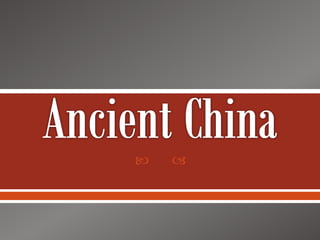
Two River Systems and North China Plain Shaped Early Chinese Civilization
- 1.
- 2. Cities grew along the banks of two rivers Isolated culture due to geography Civilization developed with few outside influences Borders: o East: Yellow Sea, East China Sea, Pacific Ocean o West: Taklimakan Desert o North: Gobi Desert o Southwest: Himalayan Mountains Gobi Desert is a cold desert.
- 3. Two River Systems Flow toward the Pac. Ocean Chang Jiang (Yangtze): central China Huang He (Yellow): northern China North China Plain o Land between the rivers o Rich farmland o Center of Chinese Civilization
- 7. Varied Climate Like the US West: dry Northeast: cold winters; warm summers Southeast: mild winters; hot, rainy summers What crops are grown in China?
- 9. Chinese & US Climates: A Comparison
- 10. 1766 BC: dynasty established Claimed to have the permission of the gods Controlled portion of the North China Plain Made war with nomadic people Treated parents & ancestors with great respect No strong central gov’t; family members ruled distant lands
- 11. Developing Language Developed pictograph writing; symbols=words Educated person knew 10,000 characters Can learn written Chinese without being able to speak it What is the advantage of a language that you can learn without speaking?
- 12. 1027 BC: defeated the Shang Rise of the Zhou created a pattern: dynastic cycle Rulers must keep the Mandate of Heaven Distant lands ruled by lords pledged to support the Zhou When lords grew in strength, they began to fight
- 14. Powerful gov’t with strict laws will keep order People will only do good if forced to Harsh punishments needed to make people afraid to do wrong
- 15. Shang Yang: those who fail to report lawbreakers should be punished Under Legalism, books were burned and those who questioned the gov’t were arrested
- 16. Confucius (551-479 BC) Order can be kept if everyone has respect for each other Leaders should serve as good examples Lower members of society should obey those above them Ideas collected in a book: Analects
- 17. Each relationship has its own duties and code of conduct Father and son Elder brother and younger brother Husband and wife Friend and friend Ruler and subject What is the nature of these relationships?
- 18. Filial piety: treating parents and elders with respect Authority should be respected Confucianism eventually adopted by Chinese rulers Guiding force that shaped Chinese culture
- 19. Laozi (500s BC) All humans must find a way (Dao) to live in harmony with nature Questions of right and wrong are pointless “People would be content with their simple, everyday lives, in harmony, and free of desire.” Gov’t should leave people alone
- 20. Yin (black): cold, dark, and mysterious Yang (white): warm, bright, and light Both forces complement each other Each changes & evolves
- 21. Started by Shi Huangdi Lasted from 221 – 202 BC Unified China after warring-states period Legalistic ruler Conquered neighbors and expanded the empire
- 23. Forced nobles to live at capital Built highways and irrigation projects to unite China Began linking existing defensive walls, starting the Great Wall of China Huangdi died in 210 BC Son took over, but was quickly overthrown
- 24. 202 BC – 220 AD Liu Bang first emperor Lowered taxes and punishments less harsh Created a bureaucracy to help run the government Created a test based on Confucianism for these scholar- officials
- 25. Liu Bang died in 195 BC Succeeded by his wife, Empress Lu She ruled on half of their young son, whom she outlived She continued to rule by putting infants on the throne Upon her death in 180 BC, all members of her family were put to death
- 26. Wudi ruled from 141-87 BC “Martial Emperor” used war to expand the empire Conquered northern Vietnam and northern Korea Chased nomadic invaders out of northern China Conquered people were encouraged to assimilate
- 28. Most people worked as farmers Farmers lived in small villages near their land Rich farmers had oxen to plow their lands South: rice North: wheat Families had personal vegetable gardens Meat and fish were expensive
- 29. Centers of trade, education, and government Merchants, government workers, craftspeople Problems of modern cities: crowded, street gangs http://www.youtube.com/watch?v=VS7pKZJ3zPs
- 30. During the Han dynasty, only the Chinese knew how to make silk. Desired luxury item Roads linking China to Eurasian were built to trade silk One of the first global trading networks
- 32. Cities sprouted up around the trail. Goods leaving China: silk, paper, jade, pottery Goods coming to China: sesame seeds, oil, metals, precious stones, Central Asian horses
- 33. Silk Roads also brought ideas and customs to and from China (cultural diffusion) During the Han dynasty, Buddhist missionaries from India brought Buddhism to China Buddhism gained many followers after the fall of the Han. Why? http://www.youtube.com/watch?v=vfe-eNq-Qyg
- 35. Agricultural Improvements Two-bladed plow Wheelbarrow Water Mills o Using water power to grind grain Collar Harness for horses o Allowed horses to pull heavier loads
- 36. Paper 105 AD Made from old rags, tree bark, and fibers from hemp How did the invention of paper help the Chinese people?
- 37. Silk For 3,000 years, only the Chinese knew how to make Used to get silver and gold from the west At one time one pound of silk = one pound of gold How much is a pound of gold worth today? $24,522.77